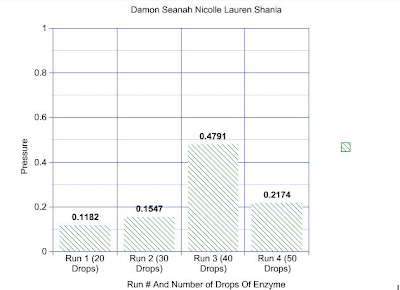The second test we did was with the yeast. With this test I thought that the more yeast we put in, the quicker we would have the reaction of the sensor plug popping off.
After the plug popped off with the yeast test, the yeast went everywhere!! It was pretty intense actually! It scared me! The plug popped off with both tests at 30, 40, and 50 drops. All of the test tubes that we had, had the plug pop off!!
When we added temperature to the test tubes I thought that it would slow down the reaction a little bit.. It ended up being that we had to have the perfect temperature to have a reaction because it being too hot slowed it down and it being too cold also slowed it down a lot. This graph is Test #1.
This graph is for Test #2
This is the graph for test #3






